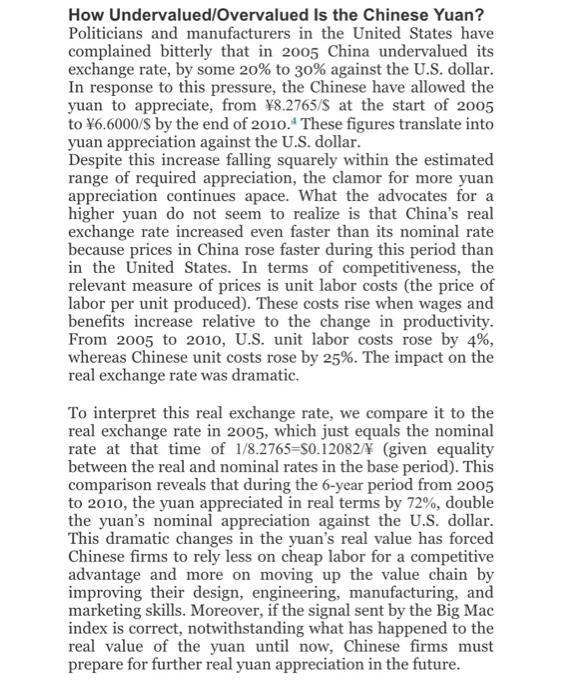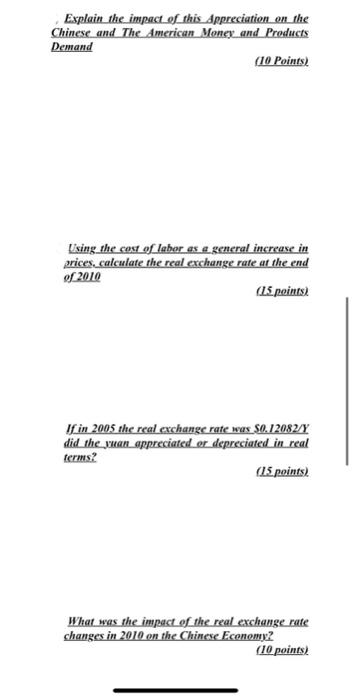please answer all these quesntion they are all one thank you ill thumbs up
How Undervalued/Overvalued Is the Chinese Yuan? Politicians and manufacturers in the United States have complained bitterly that in 2005 China undervalued its exchange rate, by some 20% to 30% against the U.S. dollar. In response to this pressure, the Chinese have allowed the yuan to appreciate, from 8.2765/$ at the start of 2005 to 6.6000/S by the end of 2010. These figures translate into yuan appreciation against the U.S. dollar. Despite this increase falling squarely within the estimated range of required appreciation, the clamor for more yuan appreciation continues apace. What the advocates for a higher yuan do not seem to realize is that China's real exchange rate increased even faster than its nominal rate because prices in China rose faster during this period than in the United States. In terms of competitiveness, the relevant measure of prices is unit labor costs (the price of labor per unit produced). These costs rise when wages and benefits increase relative to the change in productivity. From 2005 to 2010, U.S. unit labor costs rose by 4%, whereas Chinese unit costs rose by 25%. The impact on the real exchange rate was dramatic. To interpret this real exchange rate, we compare it to the real exchange rate in 2005, which just equals the nominal rate at that time of 1/8.2765=$0.12082/4 (given equality between the real and nominal rates in the base period). This comparison reveals that during the 6-year period from 2005 to 2010, the yuan appreciated in real terms by 72%, double the yuan's nominal appreciation against the U.S. dollar. This dramatic changes in the yuan's real value has forced Chinese firms to rely less on cheap labor for a competitive advantage and more on moving up the value chain by improving their design, engineering, manufacturing, and marketing skills. Moreover, if the signal sent by the Big Mac index is correct, notwithstanding what has happened to the real value of the yuan until now, Chinese firms must prepare for further real yuan appreciation in the future. Explain the impact of this Appreciation on the Chinese and The American Money and Products Demand (10 Points) Lising the cost of labor as a general increase in prices, calculate the real exchange rate at the end of 2010 (15.points) If in 2005 the real exchange rate was $0.12082/Y did thewan appreciated or depreciated in real terms? (15 points, What was the impact of the real exchange rate changes in 2010 on the Chinese Economy? (10 points: How Undervalued/Overvalued Is the Chinese Yuan? Politicians and manufacturers in the United States have complained bitterly that in 2005 China undervalued its exchange rate, by some 20% to 30% against the U.S. dollar. In response to this pressure, the Chinese have allowed the yuan to appreciate, from 8.2765/$ at the start of 2005 to 6.6000/S by the end of 2010. These figures translate into yuan appreciation against the U.S. dollar. Despite this increase falling squarely within the estimated range of required appreciation, the clamor for more yuan appreciation continues apace. What the advocates for a higher yuan do not seem to realize is that China's real exchange rate increased even faster than its nominal rate because prices in China rose faster during this period than in the United States. In terms of competitiveness, the relevant measure of prices is unit labor costs (the price of labor per unit produced). These costs rise when wages and benefits increase relative to the change in productivity. From 2005 to 2010, U.S. unit labor costs rose by 4%, whereas Chinese unit costs rose by 25%. The impact on the real exchange rate was dramatic. To interpret this real exchange rate, we compare it to the real exchange rate in 2005, which just equals the nominal rate at that time of 1/8.2765=$0.12082/4 (given equality between the real and nominal rates in the base period). This comparison reveals that during the 6-year period from 2005 to 2010, the yuan appreciated in real terms by 72%, double the yuan's nominal appreciation against the U.S. dollar. This dramatic changes in the yuan's real value has forced Chinese firms to rely less on cheap labor for a competitive advantage and more on moving up the value chain by improving their design, engineering, manufacturing, and marketing skills. Moreover, if the signal sent by the Big Mac index is correct, notwithstanding what has happened to the real value of the yuan until now, Chinese firms must prepare for further real yuan appreciation in the future. Explain the impact of this Appreciation on the Chinese and The American Money and Products Demand (10 Points) Lising the cost of labor as a general increase in prices, calculate the real exchange rate at the end of 2010 (15.points) If in 2005 the real exchange rate was $0.12082/Y did thewan appreciated or depreciated in real terms? (15 points, What was the impact of the real exchange rate changes in 2010 on the Chinese Economy? (10 points








